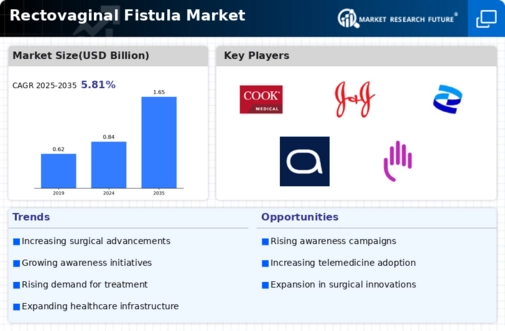Market Analysis
In-depth Analysis of Rectovaginal Fistula Market Industry Landscape
Market Dynamics of the Rectovaginal Fistula Market
-
Increasing Incidence of Rectovaginal Fistulas: The prevalence of rectovaginal fistulas is rising, primarily due to factors such as childbirth complications, pelvic surgeries, and inflammatory bowel diseases. The increase in the number of cases drives demand for effective treatments and surgical interventions, fueling market growth.
-
Growing Awareness and Diagnosis: Enhanced awareness about rectovaginal fistulas and advancements in diagnostic technologies are contributing to the growth of the market. Improved diagnostic capabilities help in early detection and accurate diagnosis, leading to timely treatment and management of the condition.
-
Advancements in Treatment Options: The market is witnessing continuous innovations in treatment methods, including surgical techniques and minimally invasive procedures. New treatments, such as advanced surgical repair techniques and biologic therapies, are improving patient outcomes and driving market expansion.
-
Rising Healthcare Expenditure: Increased healthcare spending globally is positively impacting the rectovaginal fistula market. Higher healthcare budgets allow for better access to advanced medical technologies and specialized treatments, leading to improved management of rectovaginal fistulas.
-
Enhanced Supportive Care Services: The growth of supportive care services, including patient education, counseling, and post-surgery rehabilitation, is contributing to market dynamics. Comprehensive care and support services improve patient quality of life and treatment success rates.
-
Challenges in Treatment Access: Despite advancements, challenges such as limited access to specialized healthcare facilities, especially in low-resource settings, can impact market growth. Geographic disparities in healthcare access affect the availability and delivery of effective treatment options.
-
Regulatory and Reimbursement Policies: The rectovaginal fistula market is influenced by regulatory and reimbursement policies. Positive changes in healthcare regulations and reimbursement structures can enhance market growth by increasing accessibility and affordability of treatments.
-
Investment in Research and Development: Ongoing research and development activities in the field of rectovaginal fistulas are driving innovation and market growth. Investment in new technologies and therapies aims to address unmet medical needs and improve treatment efficacy.
-
Patient Demographics and Lifestyle Factors: Changing patient demographics and lifestyle factors, such as increasing rates of obesity and cesarean sections, contribute to the prevalence of rectovaginal fistulas. Understanding these factors helps in targeting interventions and treatment strategies effectively.
-
Collaboration and Partnerships: Collaborations between healthcare providers, researchers, and pharmaceutical companies are advancing the development of new treatments and technologies. Partnerships facilitate the exchange of knowledge and resources, promoting market growth and innovation.
-
Economic Factors: Economic conditions and healthcare funding availability can influence market dynamics. In regions with limited resources, the market may face constraints due to affordability issues and limited access to advanced treatment options.
-
Patient Advocacy and Support Groups: The role of patient advocacy and support groups in raising awareness and providing resources for rectovaginal fistula patients contributes to market dynamics. These organizations help in improving patient access to information and treatment options.
Overall, the rectovaginal fistula market is shaped by a combination of increasing incidence, advancements in treatment, healthcare expenditure, and challenges related to access and regulation. Continued innovation and support for affected patients are essential for the ongoing growth and development of the market.

















Leave a Comment